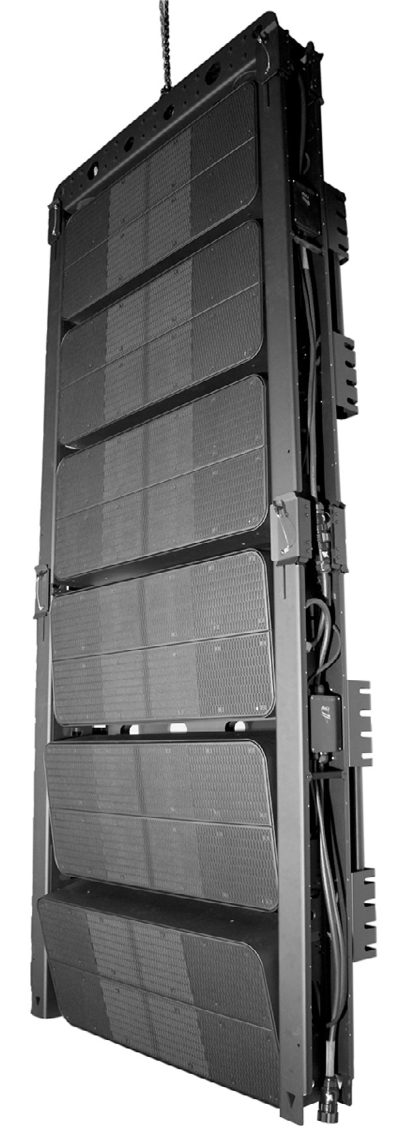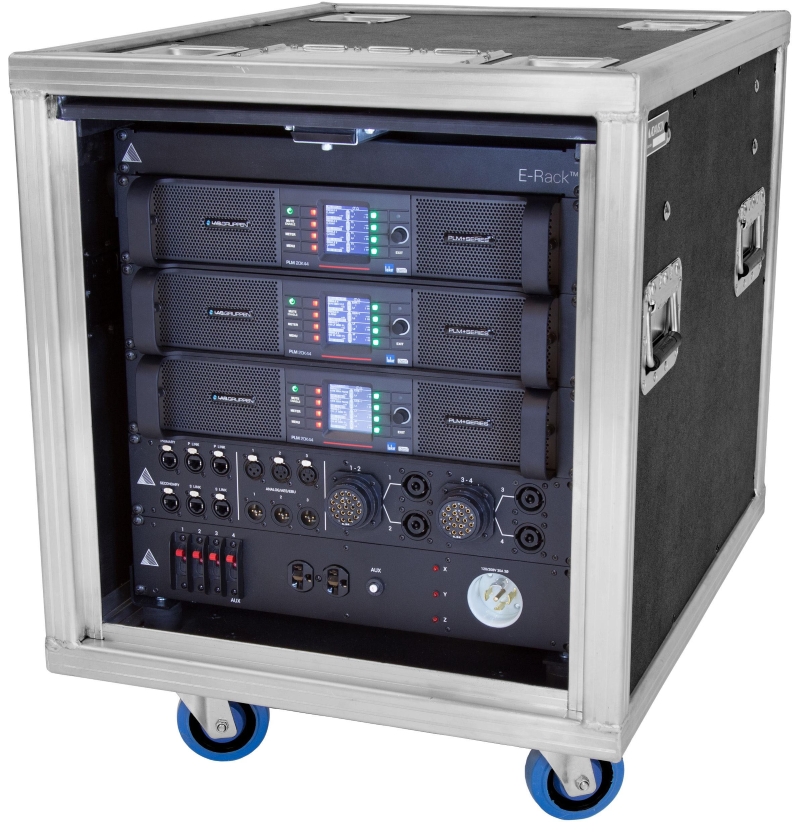
Because line arrays are stacked and used in multiples to create a coherent wavefront, part of the design is for the mid- and high-frequency outputs to be evenly dispersed to the top and bottom edges of the enclosure, to meet and blend with the outputs of adjacent cabinets.
In addition, assuring that the driver spacing between those covering the same frequency range is within half a wavelength or less allows coupling of their output, so the geometry of the component layout is a critical design factor.
The rigging and splay systems also promote the close spacing of line array enclosures, as well as assuring the safety and balance of the array, easing setup and teardown, and ensuring the reliability of the provided splay angles.
For example, Martin Audio designs systems such as the MLA Mini so that a single engineer can build the array and adjust the splay angle from a single position in the rear, while a universal tilt bracket can set the downward tilt of the entire array over 18 degrees with the turn of a knob.

Meyer Sound LEO builds clearly labeled splay angle points into the enclosure side plates.
K-Array has a unique approach included in systems such as the KH8, where full-range arrays are flown vertically, but each unit has the ability to be tilted totally independent. The result is a “straight array” (vertically), but one that has a wavefront with the desired curvature from a vertical cluster.
KH8 modules are anchored in groups of three within rigid frames that can be connected quickly to create longer clusters. The three units inside each frame remain cabled, and are ready by simply connecting only two cables from each frame to the next.
The rigging system allows a single person to pre-cable stacks of three units to fly a straight 12-unit array. Every unit can be independently tilted to focus the sound mechanically and then digitally steered.
Clair C15 enclosures are equipped with integrated bimodal rigging, including rear rigging that allows the array to be adjusted from 0 to 10 degrees at 0-, 1.25-, 2.5-, 3.75-, 5, 7.5- or 10-degree increments, flown or stacked. Increased angular resolution is available using Bimodal Incremental Rigging Disc (B.I.R.D.) accessories that add 0.5-, 0.75-, 1-, and 1.25-degree increments between listed angles.
Amplification
Another important choice that line array designers make is whether to integrate the DSP and amplification into the enclosure itself or keep the enclosures passive and use dedicated external amps and system controllers. Some companies offer a choice of both, such as Renkus-Heinz with VARIAi systems available in self-powered or passive versions.
Self-powered enclosures ideally give the precise amplification, crossover point, and control to each component, alleviate potential damping factor problems with long cable runs from amp to cabinet, can allow the control of each cabinet’s (or in some cases, each component’s) output externally, and take up less space in a truck than separate loudspeakers and amp racks.
Meyer Sound has long been a leader in onboard power, with other examples abounding, such as the EAW Adaptive Series, Martin Audio MLA, and many others.
The new RCF HDL 6-A sports an onboard 2-channel class D amplifier rated at 1,400 watts, working with integrated DSP for managing crossover, equalization, soft limiter, compressor and dynamic bass boost. In addition, new proprietary FiRPHASE algorithms further optimize dynamics, amplitude and phase patterns, even on mid-low frequencies.
External amplification is also widely used, mainly with proprietary electronics packages that provide amp channels, DSP and driver control, networking, and often digital audio connections.

L-Acoustics offers a range of amplified controllers that work in tandem with its systems, as well as the LA RAK, a modular touring rack designed for all of the company’s loudspeakers. It includes analog signal, network and power distribution panels, and the 9RU frame is engineered to allow rigging and flying.
The Adamson E-Rack incorporates premium Lab.gruppen PLM+ amps, Lake processing, and Dante audio networking, plus proprietary connector and AC panels, and it all works in tandem with Blueprint AV system coverage design software.
JBL VTX arrays are powered with sister company Crown’s VRack DSP and amplification units and controlled via HiQnet Performance Manager.
Alcons Audio has rolled out the Sentinel 10 amplified loudspeaker controller (ALC) that provides array compensation, filter presets, EQ, and phase matching along with power.
Martin Audio just launched Wavefront Precision, comprising the WPC (2 x 10-inch) and WPM (2 x 6.5-inch) with new external iKON multi-channel amplifiers optimized by the company’s automated DISPLAY software.
“What we wanted to do with Wavefront Precision was to introduce a solution whereby customers could have a flexible and scalable approach to resolution and control of coverage,” explains Martin Audio managing director Dom Harter. “Simply put, the more boxes with dedicated amplifier channels, the higher the resolution and scale of coverage control achievable.”
